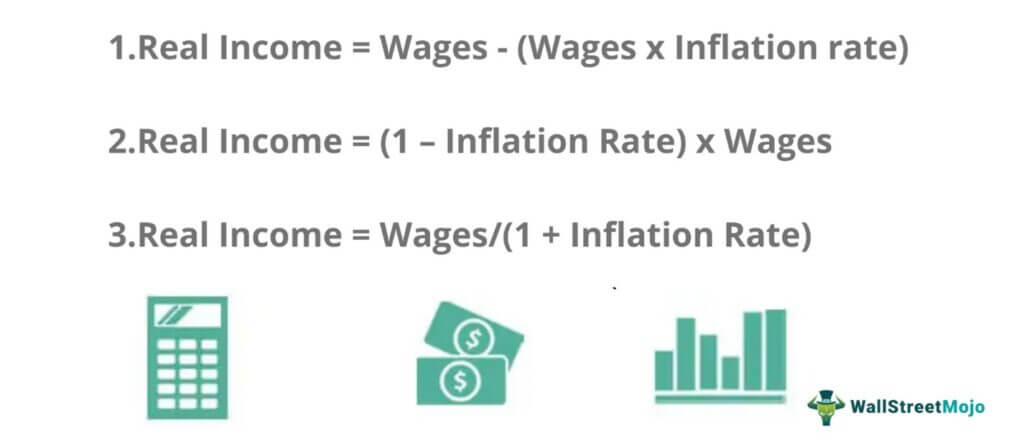Table Of Contents
Real Income Meaning
The Real income of an individual or a country is income adjusted for inflation. It is different from nominal income in which no such adjustments are made. Therefore, an individual must track their real and nominal wages to comprehend their purchasing power.

It is reported by CPI (Consumer Price Index). It is an indicator of an individual's well-being, the standard of living, and economic health. When inflation increases, the fall in real income is denoted in terms of inflation per dollar. It is also referred to as real wage.
Key Takeaways
- Real income in economics determines purchasing power and financial stability of an individual based on income and inflation.
- Inflation has been a concrete aspect of society. It is the relationship between a citizen's wages and the rising prices.
- Inflation overwhelms the citizens—they have fixed wages and no other source of finance. A certain basket of available items a year ago will now cost more.
- It is the difference between the economic inflation rate per dollar of income. The GDP Price Index is a reliable measure of inflation.
- Deflation, on the other hand, is a negative inflation rate. Inflation and real wage have an inversely proportional relationship.
Real Income Explained
Real income is nominal income adjusted for inflation. It signifies where a person stands in the context of buying items—the standard of living. It affects the buying process of every individual.
The purchasing power metric has the following characteristics:
- Real income in economics determines purchasing power and financial stability of an individual based on income and inflation. Inflation has been a concrete aspect of society. It is the relationship between a citizen's wages and the rising prices.
- Inflation overwhelms the citizens—they have fixed wages and no other source of finance. A certain basket of available items a year ago will now cost more.
- It is the difference between the economic inflation rate per dollar of income. The GDP Price Index is a reliable measure of inflation.
- Deflation, on the other hand, is a negative inflation rate. Inflation and real wage have an inversely proportional relationship.
Now, let us apply the concept to a hypothetical scenario. In 2017, an individual with an annual salary of $100,000 started the job with no promotion and appraisal. If the annual inflation rate is 3%, the value of $100,000 falls by 3% every year as goods and services get more expensive.
After the first year, the individual's salary equals $97000 for goods and services. In the second year, the value decreases to $94,090. If we apply it to consecutive years, by 2022, the individual's real wage will become $85,873.
Real Income Formula
There are three common formulas for determining real income:
- Real Wage = Wages - (Wages x Inflation rate)
- Real Wage = Wages/(1 + Inflation Rate)
- Real Wage = (1 – Inflation Rate) x Wages
Depending on the available variables, one of the formulas is used.
Example of Real Income
According to JPMorgan Chase & Co., pensions oversee $30 trillion in Britain, the U.S., Japan, and Europe. Boomers and the like may lose the most from price pressures, rising rates, and bonds—accounting for 45% of assets held by pension funds and insurers—in the world's biggest markets.
These funds have boosted bonds allocations, as easy-money policies encourage governments and companies to borrow at rock-bottom rates.
There is a downside; inflation would affect people with fixed wages the most—especially when their wage is not inflation-indexed. Most retirees fall in this category—their wages will not catch up with inflation and rising prices.
The older generation is at a financial disadvantage owing to their fixed-wage preference. The Treasury index witnessed losses from 2021 onwards—an event last witnessed in 1974—as the Federal Reserve tried to consolidate the impact of the pandemic. Recently, U.S. government bonds lost 1.5%.
While pension funds have enjoyed a bullish run until last year, the older crowd is now struggling with the asset class's negative returns. In contrast, young traders appear to be decidedly more relaxed. This real income example highlights the impact of inflation on living standards.
Real Income vs Nominal Income
- Real income is adjusted for inflation; it is not the case with nominal income or nominal wage.
- Nominal wage is the amount an individual earns—real wage is the actual purchasing power of the individual.
- Nominal wage can remain constant for years, but real wage fluctuates.
- Real wage has an inverse relationship with inflation.
- The real wage in economics varies as certain factors cannot be assumed constant. Nominal wage, on the other hand, remains the same.
- When it comes to understanding important concepts like the national economy, the well-being of citizens, etc., real wage is more comprehensive than nominal wage.

